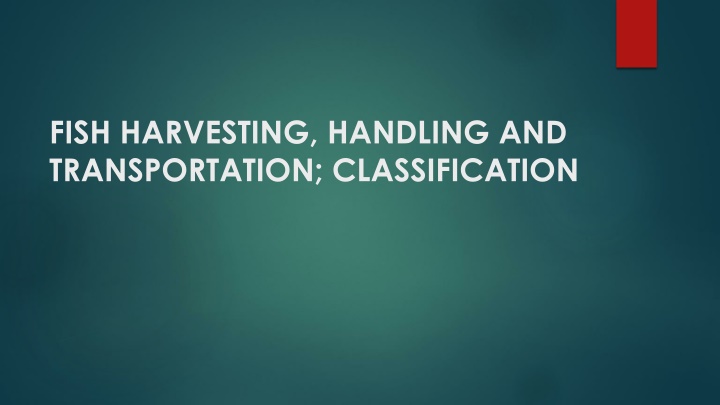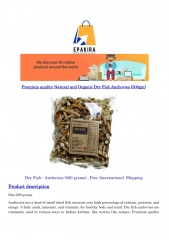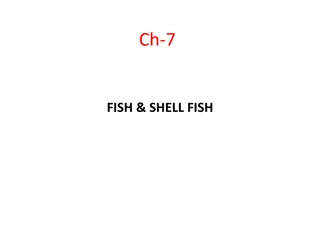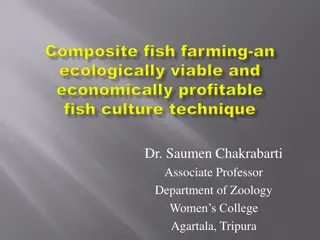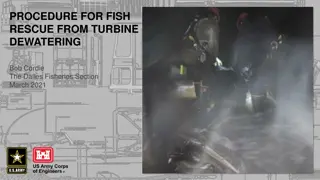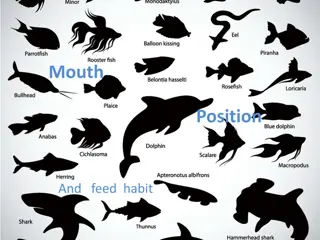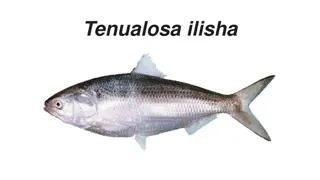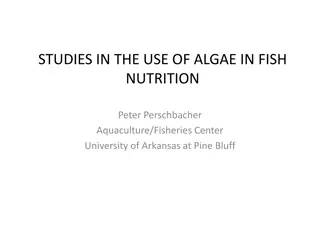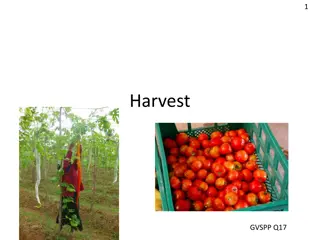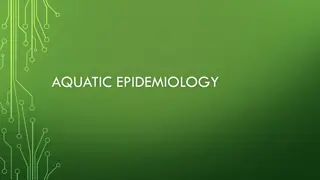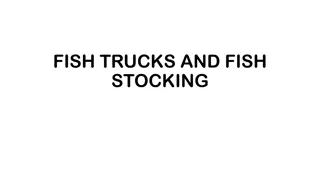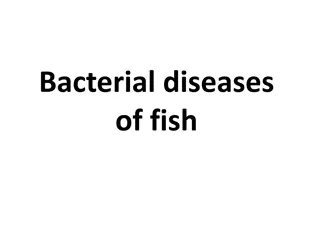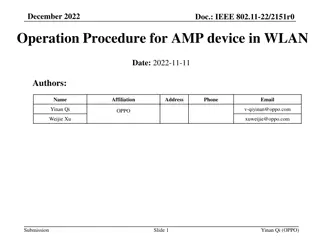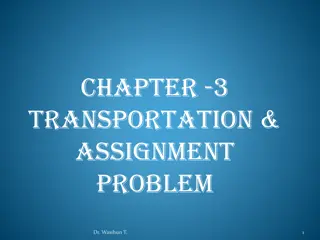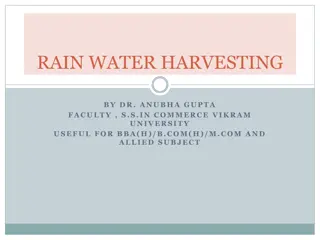Overview of Fish Harvesting, Handling, and Transportation
Fish harvesting is crucial for providing valuable animal protein, with India being a key player in fish production. Fisheries are categorized into fin and non-fin types, with capture and culture fisheries being common practices. Capture fisheries involve natural species recruitment in sea and inland waters, while culture fisheries focus on cultivating selected fish for maximum yield. Various fishing techniques are employed, ranging from simple methods like hand picking to sophisticated systems like mid-water trawling. Harvest technologies include netting, trapping, and baiting to catch fish efficiently.
Download Presentation

Please find below an Image/Link to download the presentation.
The content on the website is provided AS IS for your information and personal use only. It may not be sold, licensed, or shared on other websites without obtaining consent from the author.If you encounter any issues during the download, it is possible that the publisher has removed the file from their server.
You are allowed to download the files provided on this website for personal or commercial use, subject to the condition that they are used lawfully. All files are the property of their respective owners.
The content on the website is provided AS IS for your information and personal use only. It may not be sold, licensed, or shared on other websites without obtaining consent from the author.
E N D
Presentation Transcript
FISH HARVESTING, HANDLING AND TRANSPORTATION; CLASSIFICATION
Introduction Fish is a source of valuable animal protein and is now considered as a health food. India is the 3rd largest fish producing nations (after Chine and Indonesia) in the world with the production of 7.3 million MT (FAO 2007). Presently, fisheries and aquaculture contribute 1.10 % to the national GDP, and 5.30 % to agriculture and allied activities, while the average annual value of output during the Tenth Five Year Plan (2002-2007) was Rs31, 682.50 crores.
Classification of fisheries Fisheries can be broadly categorized into two types fin fisheries and non-fin fisheries. a. b. Fin fisheries means fisheries of true fishes, whereas non-fin fisheries is the fisheries of organisms other than true fish like prawn, crab, lobster, mussel, oyster, sea cucumbers, frog, sea weeds, etc. Fin fisheries can be further categorized into two types capture fisheries and culture fisheries. a. b.
Capture fisheries It is the exploitation of aquatic organisms without stocking the seed. Recruitment of the species occurs naturally. Capture fisheries is carried out in the sea, rivers, reservoirs, etc. Fish yield decreases gradually in capture fisheries due to indiscriminate catching of fish. Capture fisheries practiced in the sea is referred as marine fisheries and Inland capture fisheries if it is in the rivers or reservoirs.
Culture fisheries It is the cultivation of selected fishes in confined areas with utmost care to get maximum yield. The seed is stocked, nursed and reared in confined waters and then the crop is harvested. Culture takes place in ponds, which are fertilized and supplementary feeds are provided to fish to get maximum yield.
Fish harvesting Fishing techniques are methods for catching fish. Use of fishing methods varies, depending on the types of fisheries, and can range from as simple process as gathering of aquatic organisms by hand picking to highly sophisticated fish harvesting systems, viz. aimed mid-water trawling or purse seining conducted from large fishing vessels. The targets of capture fisheries can range from small invertebrates to large tunas and whales.
Harvest technologies, as they are practiced today generally fall into 3 main groups: Catching fish singly or in schools by use of nets or spears Trapping fish in stationary gears such as fish traps or set nets Attracting fish to get caught on hooks by use of bait, artificial lures or other means such as light.
Fish harvesting methods Fish harvesting systems includes fishing vessels (craft) and fishing gear. The traditional methods of fish harvesting Ring seine, Stake net, Chinese dip net, Cast net, Shore seine, Trammel net, Mini trawls, Gill nets, Hook and line, traps and pots Modern methods of fish harvesting Trawling, Purse seining, Hook and line mechanized Jigging and Trolling lines.
Handling of fishes Since fish is highly perishable commodity, it is to be immediately processed into various products to preserve its quality and to increase the shelf life. Fish requires proper handling and preservation to increase its shelf life and retains its nutritional attributes. Fish are particularly prone to rapid pathogenic contamination. The main safety concerns are unhygienic handling during and after fish harvest, insufficient refrigeration, substandard processing and poor packaging. Maintaining the quality of the fish begins with harvest and carries through the harvest to consumption chain.
For harvested fish, the general handling practices after capture are: Transferring catch from gear to vessel, Washing/Sorting, Bleeding/gutting, Chilling, Chilled storage and unloading, a. b. c. d. e. The most important factors to be considered in the initial handling and transport are the temperature, duration of storage/ transport and the hygiene in all respects including that of the handlers.
Washing and sorting of fish The harvested fish should be washed well with potable water to free it from dirt and other extraneous matter. Slime accumulating on the skin surface of dying fish is a protection mechanism against harmful conditions. Dressing Dressing operations of the catch include deheading, bleeding and gutting. This has to be carried out as fast as possible without significant bacterial contamination. Gills and viscera harbour several spoilage bacteria in large number. Therefore, it is advisable to remove the gills and viscera before the fish is preserved and stored.
Deheading The head constitutes 10-20% of the total fish weight and it is cut off as an inedible part. Bleeding When fish dies, the blood in the fish can clot and turn black or brown in color adversely affecting the color and appearance of the meat. Therefore bleeding is done. Slitting the throat followed by hanging the fish by tail or slitting the throat and immersing in cold water are the methods for bleeding. Gutting Gutting consists of cutting down the belly (fish may be deheaded or not), removal of internal organs, and, optionally, cleaning the body cavity of the peritoneum, kidney tissue and blood.
Chilling and storage Decreasing the temperature of the fish to about 0 C slows down the microbiological, chemical and biochemical decomposition processes and extends fish stability. The most common means of chilling is by the use of ice. Fish spoil more quickly if: It has struggled for long in the net or inboard, than a fish, which is killed quickly. Its stomach is full while catching, It is bruised while catching or handling a. b. c.
Transportation of chilled fish Fish is transported both through air and land. Land transportation of chilled fish is carried out in insulated or mechanically refrigerated vehicles with minimum inside temperature of 70C. Boxes for land transportation are made of wood, aluminum, high density polyethylene, expanded polystyrene or polyurethane. The ideal fish transpiration box should be light weight yet strong enough to withstand the combined weight of fish, ice and stacking and should have good insulating properties. Boxes are usually made of double bottom to collect the melt water.
Air shipment of chilled fish requires a lightweight and protective container. Modern insulated containers are made of high-density polypropylene with polyurethane insulation. Instead of ice, pads of nonwoven fabric encapsulating synthetic absorbent powder are used for chilling of air shipped fish. These pads could be soaked in water and deep frozen for use. Plywood boxes insulated with 2.5cm thick foamed polystyrene slabs are found to be more useful to transport fish over longer distances involving duration of 60-80hrs.
